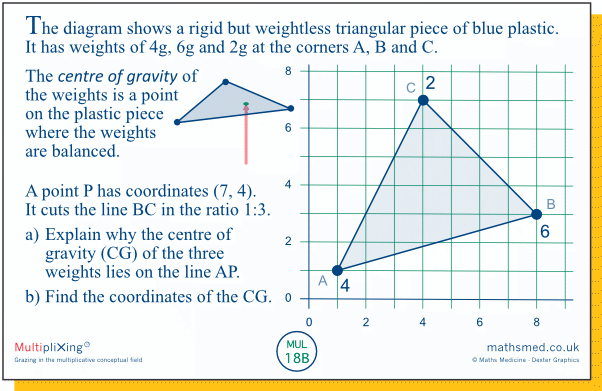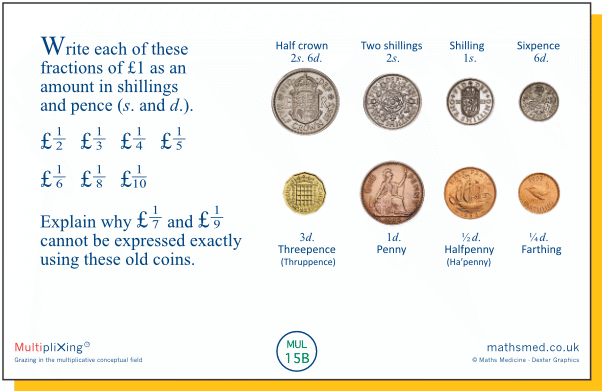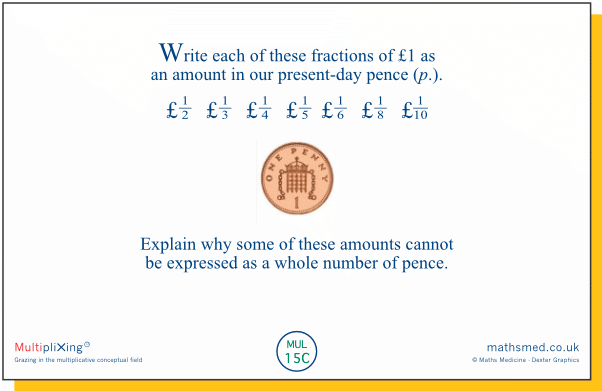22 October 2021
27 September 2021
MUL 20
Note: GERMAN versions of the Week 20 tasks are available HERE.
Here we look at two interpretations of division: quotition and partition (or measurement and sharing). We use a double number line (DNL) to model the two forms and try to make sense of them for different sets of numbers. Starting with a dividend of 12, we examine the models when the divisor is a factor of the dividend (3), a smaller non-whole number (2.4), a larger whole number (30) and a number less than 1 (0.3).
As we shall see, both interpretations can be made to work for all these sets of dividend-and-divisor, though in some cases neither interpretation, or only one, fits easily. It is hoped that the challenges that the students experience will deepen their understanding of division, while at the same time underlining the importance of also developing a formal understanding of division as the inverse of multiplication.
For example:
The latter fits the partitive form of division, which we consider in Tuesday’s task:
12 sweets are shared between 3 people; how many sweets do they get each?
At first sight, such a story doesn't seem to work so well for 12÷2.4:
12 sweets are shared between 2.4 people; how many sweets do they get each?
However we can tweak the story to make a better fit:
12 sweets fill 2.4 packets; how many sweets fill one packet?
The DNL shows that the answer is 5. However, some students might reject this on the basis that the interpretation is too contrived.
Wednesday: Quentin is thinking of quotitive division again, so is asking ‘How many 30s in 12?’. This might seem a bit strange, and perhaps unanswerable for younger students, but a careful interpretation of the DNL suggests ‘about one-third’ (actually ¹²⁄₃₀ or ²⁄₅). Students might disagree as to whether this makes sense.
Parin is partitioning 12 into 30 equal parts. If this is phrased as ‘12 cakes are shared between 30 people; how many cakes do they get each?’, it may seem a bit odd, and impossible for younger students, perhaps. However, the answer of ‘about one-third’ (actually ¹²⁄₃₀ or ²⁄₅) can be read fairly readily from the DNL. This would probably make sense to more students than in Quentin’s case, especially if the matching story is rephrased slightly, with ‘how many cakes’ replaced by ‘how much cake’.
Parin is partitioning 12 into 0.3 pieces, or perhaps asking 12 sweets are shared between 0.3 people; how many sweets do they get each? Neither idea seems to make immediate sense, but we could rephrase the story like this:
0.3 people get 12 sweets; how many sweets does 1 person get?
Or we could revise it like this:
12 sweets fill 0.3 packets. How many sweets fill one packet?
Students might accept that the answer of about 40, as shown on the DNL, fits one or other story well enough.
You could again take this further by asking students to think of other diagrams to represent these two divisions, or to come up with stories that fit.
26 September 2021
MUL 19
Note: GERMAN versions of the Week 19 tasks are available HERE.
In this week’s tasks we focus on a family of larger and larger squares, where the multiplicative relation between the length of side of a square and that of its immediate larger neighbour is the same for all squares. The ‘super-multiplicative’ growth in the sides of the squares as we go from one square to the next, to the next, to the next.... is called exponential growth. Some of the ideas here are quite demanding, but even if they are not thoroughly understood, students can benefit from meeting this interesting (and currently, vital) mathematical concept.
In the earlier tasks, we found that shape A₄ was roughly twice as tall as shape A. Here it happens slightly 'later': R₅ is twice as tall as R.
and so m = √5 ≃ 2.2
and so the middle red line is about 22mm long.
Students might find it hard to derive a method for finding the length of the middle red line. But nonetheless, some might hit upon the idea of multiplying 10 by the square root of 5....
We can show that 10m2 = 50, as follows.
green line is m times the shorter one.
As the longer green line is m times the
shorter green line, the scale factor is m.
So the longer red line is m times 10m.
MUL 18
However, students would benefit from knowing some physics for these tasks, especially the idea of moment of a force about a point, or more loosely for our purposes, moment of a weight about a point, which is proportional to the size of the weight and to its distance from the point. Further, and crucially, if the moments for several weights about a point ‘cancel’ out, the weights are balanced about that point and the point is the centre of gravity.
There isn’t much scope to assess or develop these notions from physics in this limited set of tasks, though a small opportunity to do so is provided in the course of Monday’s introductory task.
Monday: The main purpose of this task is to introduce the ideas needed for the rest of the week’s tasks, namely centre of gravity and the inverse relation between the ratio of a pair of weights and the ratio of the distances from their centre. As such, the task is rather perfunctory, but you might want to take the opportunity offered by the question, Can you explain why?, to explore and perhaps develop students’ knowledge of moment of a force.
The notion of moments is attractive because it is easy to apply. But for those who are unsure about why it works, it might be worth looking at another idea which seems so obvious it can be thought of as a fundamental principle:Two identical weights are equivalent to a single weight of twice the size, operating at the point midway between them.
The principle can be applied to unequal weights too, by combining or splitting weights or parts of weights. So, for example, we can find the centre of gravity in the current task by performing the sequence of transformations below.
[Note that at each stage, the sum of the moments about P is zero.]
In part b) we are told that this new point has coordinates (11, 6). This is quite near C which indicates that the extra weight is quite large....
A neat way of solving part b) is to think of the original four weights as equivalent to a weight of 4g at the point P, so that the extra weight at C becomes the only weight at C. We can then observe that the centre of gravity of the 4g weight and the extra weight at C cuts the line segment PC in the ratio 2:1. This means that these two weights are in the ratio 1:2, and so the mass of the extra weight is 8g.
25 September 2021
MUL 17
Note: GERMAN versions of the Week 17 tasks are available HERE.
In this week's tasks we compare fractions with different denominators. Over the years, students will have met grounded methods of doing so, for example methods that involve partitioning a given shape into a carefully chosen number of equal parts. And by now they will also have met formal methods, based on transforming given fractions into equivalent fractions such that the resulting fractions have a common denominator. But even with such formal methods, it remains important that students have secure models of fractions that they can fall back on to support their thinking. So in this week's tasks we revisit the notion of fractions as parts of a whole, modelled by partitioning a shape into equal parts.
Note: This task is highly structured and it could be beneficial, and more satisfying, to loosen it. Thus, rather than simply presenting students with Frodo’s method, for them to make sense of, one could try to help them to construct the method themselves. So one could presnt students with just the diagram and then ask them to use it to find the difference between ⅟₂ and ⁴⁄₉, and then to look for a way of using the result to find the difference between ⅟₈ and ⅟₉.
Thursday: Here we use a circular disc as our whole, rather than a rectangular strip. Apart from that, the method used to find the desired fraction is the same as Flo’s method in Wednesday’s task.
It can be useful and illuminating for students to find ways to check their answer.
One approach would be formally to calculate ⅟₅ – ⅟₇ using the common denominator 35.
A more grounded version of this would be to express the regions in the diagram as 35ths: we have found that a yellow region represents ²⁄₃₅ of the disc; a ⅟₇ region can be written as ⁵⁄₃₅; if we add these regions, do we get ⅟₅ of the disc?
MUL 16
Note: GERMAN versions of the Week 16 tasks are available HERE.
In this week's tasks we consider the squares of numbers, as we did in Week 2, but this time with a more sustained focus on the difference of two squares. Formally, this relation can be derived from the fact that when we expand the brackets in (a + b)(a – b), the two ab terms cancel out and we are left with a² – b². However, we take a more grounded approach in this set of tasks, in that we infer the rule from specific numerical cases, in particular cases where a – b = 1. We then suggest a way of verifying the rule (for a – b = 1) using an argument based on structural arithmetic.
32.6 × 31.6 = 31.6² plus an extra 31.6;
32.6 × 32.6 = 32.6 × 31.6 plus an extra 32.6
An equivalent approach is to use the area model: we can think of a 32.6 units square as consisting of a 31.6 units square with a 31.6 by 1 strip (blue) along one edge, and then a 32.6 by 1 strip (red) along an edge perpendicular to the first edge.
Of course, we can’t always make a valid generalisation from a single case, though intuition suggests it must work here: how could the squares of other (positive) consecutive numbers possiby behave differently?! We can prove the result by, for example, using the area-model diagram in task 02B, or algebraically, as here:
The squares of the (positive) consecutive numbers a, a+1 and a+2 are
a², a² + 2a + 1 and a² + 4a + 4,
so the differences are 2a + 1 and 2a + 3,
and 2a + 3 > 2a + 1 (and |2a + 3| > |2a + 1| when a is positive).
Note: In the task we deliberately refer to the expressions 292, 302 and 312 as numbers, to make the point that we can think of expressions as numbers even when we haven’t found their value. You might need to clarify this for students.
we can write this:
24×26 is 24×2 or 2×24 more than 242.
26×26 is 2×26 more than 24×26.
So 262 is 2×24 + 2×26 = 2(26 + 24) more than 242.
24 September 2021
MUL 15
In this week's tasks we express amounts of money as fractions of £1, set in the context of the coinage that was in use in the UK before decimalisation in 1971. Decimalisation simplified the currency but we lost some of the nice numerical relations that stemmed, primarily, from the fact that there were 12 (old) pence in one shilling. There are, of course, more factors in 12 than in 10! And a lot more factors in 240 than in 100....
Monday: Here we express each of the 8 coins that were in circulation at the time, as a fraction of £1. You might want to make clear to students that 1 old pence (1d.) does not have the same value as 1 new pence (1p.)

Thursday: When we work with fractions, rather than thinking of them as pure numbers, we often think of them as parts of a whole (a cake, a bar of chocolate, a rectangle). It can sometimes be helpful to ‘quantify’ this whole (in terms of its price, or weight, or area, etc) and then to work with these quantities rather than with the fractions themselves, before linking the quantities back to fractions again. That is what we do here (and again in Monday’s task of Week 17).
We have given the answers to the three fraction additions shown in this task, to emphasise that our prime aim here is not to perform the computations but to explore (or revisit) a method that may throw light on them. After students have worked through the task, you might want to ask them what other methods could be used to check the answers.
MUL 14
Note: GERMAN versions of the Week 14 tasks are available HERE.
This week we start by revisiting some of the tasks from Week 3 but this time we examine how models (such as the double number line and Cartesian graph) can help reveal whether a relationship is multiplicative or additive.
Monday: The double number line is a very powerful representation but it can take a while for students to become familiar with it and to appreciate the significance of the fact that for a multiplicative relationship the two scales are linear and the 0s are aligned.
We should again bear in mind that the graph is quite abstract and that some students might try to interpret it in a more concrete way: for example, they might see the lower point as representing Salvo’s position and the upper point as representing José’s at a particular time, with perhaps even an imagined zig-zag line of steps joining them.
18 September 2021
MUL 13
Note: GERMAN versions of the Week 13 tasks are available HERE.
In this week's tasks we take a sideways look at fraction multiplication, using area of a rectangle as a model. A common way of introducing the model is to partition a rectangle into equal parts, and then to partition the partitions, and then finally to ask students to quantify the result. In these tasks we work the other way round, by presenting students with a carefully chosen fractional part of a rectangle in the hope that students will construct suitable partitionings for themselves.
Monday: Here we can arrive at the tinted region by halving the rectangle with a vertical cut, and then cutting one of the pieces horizontally into three equal parts. Or we could proceed the other way round: cut the rectangle into three equal horizontal strips and then halve one of the strips with a vertical cut. Either way, it is fairly obvious that six versions of the tinted piece will exactly cover the rectangle, so the tinted region covers ⅙ of the large rectangle.
Notice that in our diagram we have only cut one of the halves into thirds rather than the whole rectangle. This is a more accurate representation of ‘⅓ of ½’ than halving the rectangle and then cutting the whole rectangle into thirds, as is commonly done. However, it does not explicitly show that the resulting piece is ⅙ of the large rectangle. This might be seen as a drawback, but it has the beneficial effect of prompting students to think about the relative size of the pieces.
Thursday: Here we have made things slightly more obscure - they should become clearer if one imagines the tinted region turned through 90˚.
Do any students resort to decimals: 0.25 × 0.3 = 0.075? If so, can they express 0.075 as a vulgar fraction?

















































